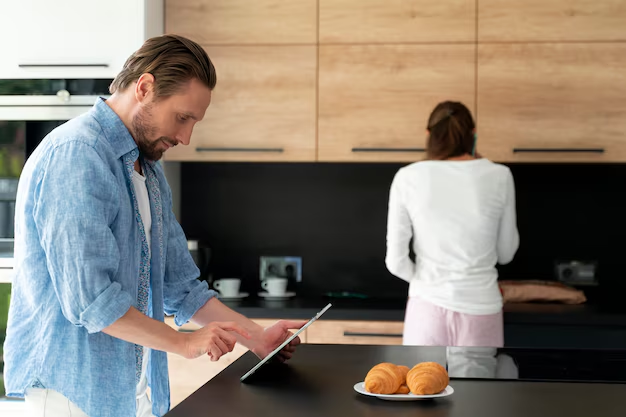Adjusting the Temperature on Your Whirlpool Refrigerator: A User's Guide
Refrigerators are the heart of a kitchen. Ensuring they run at optimal temperatures is crucial for preserving food and saving energy. If you own a Whirlpool refrigerator and are unsure how to adjust its temperature settings, you're in the right place. This guide will walk you through the process, helping you maximize your fridge's efficiency and extend the life of your groceries.
🍽️ Understanding the Importance of Proper Refrigerator Temperature
While it might seem like just another household task, the correct setting of your refrigerator's temperature is vital for food safety and appliance efficiency. Too warm, and your food could spoil faster, leading to waste and potential health risks. Too cold, and you might find frozen lettuce and excessive energy consumption.
The Ideal Temperature Range
Experts generally recommend keeping your refrigerator at a temperature of 37°F (3°C) and your freezer at 0°F (-18°C). These settings ensure your food stays fresh while minimizing the growth of harmful bacteria.
🔍 Finding the Temperature Controls on Your Whirlpool Refrigerator
Depending on the model, Whirlpool refrigerators may have different ways to adjust temperature settings. Let’s break them down:
Digital Temperature Controls
Many modern Whirlpool models come equipped with digital controls. These are often found inside the refrigerator, possibly near the top or in the door, where a simple LED or LCD panel displays the current temperatures.
- To adjust: With digital panels, changing the temperature is typically as simple as pressing the up or down arrows until you reach your desired setting.
Dial or Slider Temperature Controls
Some older or more basic models may use manual dials or sliders, usually found just inside the fridge, near the top or back.
- To adjust: Simply turn the dial or slide the control to the desired setting. These models often don’t provide an exact temperature reading, so it may take a bit of trial and error to find the perfect spot.
🧊 Adjusting Your Whirlpool Refrigerator Temperature: Step-by-Step
Before You Begin: Equipment Check
- Thermometer: For precise adjustments, it's beneficial to have a fridge thermometer on hand.
- User Manual: If possible, consult your refrigerator’s user manual for model-specific guidance.
Step 1: Assess Your Current Temperature
- Place a thermometer in the center of your refrigerator. Wait for about 24 hours to get an accurate reading.
- if the reading isn't within the ideal range, it's time to adjust!
Step 2: Adjust the Temperature
Digital Control
- Locate the control panel inside your fridge. Use the arrow buttons to adjust the refrigerator and freezer sections separately.
- Wait 24 hours: Changes take time to stabilize. Recheck with the thermometer.
Dial or Slider Control
- Turn the dial to a lower number for a cooler temperature and to a higher number for a warmer setting.
- Observe changes over 24 hours with your thermometer.
Step 3: Re-evaluate
- Check the thermometer after waiting. Adjust further if necessary using the same steps as before.
🏡 Temperature Settings for Different Seasons
Believe it or not, the time of year can impact your refrigerator’s performance. Here’s how you might tweak settings seasonally:
Summer
Warm temperatures can mean extra work for your fridge. You may find a small decrease in temperature necessary to maintain optimal efficiency. Ensure door seals are tight to prevent cool air from escaping.
Winter
In cooler environments, your refrigerator's workload is reduced. Monitor your settings to prevent unnecessary energy use, but ensure the appliance maintains food safety for winter excesses.
📈 Troubleshooting Common Temperature Issues
Even after adjustments, you might run into issues that require a bit more troubleshooting:
The Refrigerator Isn’t Cold Enough
- Check seals: Ensure door seals are free from obstructions and form a tight fit.
- Airflow: Items blocking vents inside the fridge can limit circulation and cooling.
- Condenser coils: These need regular cleaning to ensure efficient operation.
The Refrigerator Is Too Cold
- Temperature setting: Check and adjust the controls once more.
- Blocked air vents: Ensure airflow from the freezer section isn't overly chilling items in the fridge.
❄️ When to Call in Professionals
Sometimes, even after adjusting the temperature, problems persist. Here are scenarios where expert assistance may be beneficial:
- Persistent leakage: Excess moisture could indicate a mechanical issue.
- Unusual noises: Strange sounds can signal mechanical distress.
- Temperature fluctuations: If settings won’t hold, a technician might be required.
🎯 Quick Tips and Key Takeaways
Here's a handy summary to keep your Whirlpool refrigerator at peak performance:
- 📏 Ideal temperatures: 37°F (3°C) for fridges, 0°F (-18°C) for freezers.
- 📊 Check and adjust: Thermometer use provides accurate readings.
- 🛠️ Regular maintenance: Clean coils and ensure proper airflow.
- 🔍 Monitor seasonally: Adjust settings as seasons change for optimal efficiency.
Maintaining the correct temperature in your Whirlpool refrigerator is not just about food preservation but also about energy efficiency and extending the life of your appliance. With these steps, you can ensure your refrigerator works optimally year-round, keeping your food fresh and your energy bills low. Remember to check your settings regularly and perform routine maintenance to enjoy the full benefits of your Whirlpool refrigerator.
